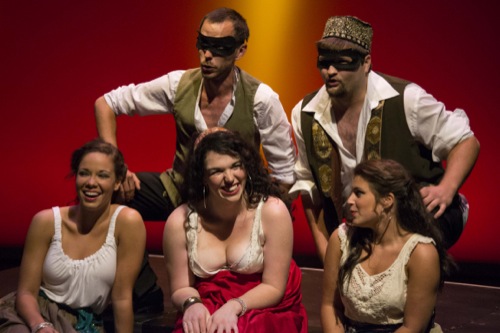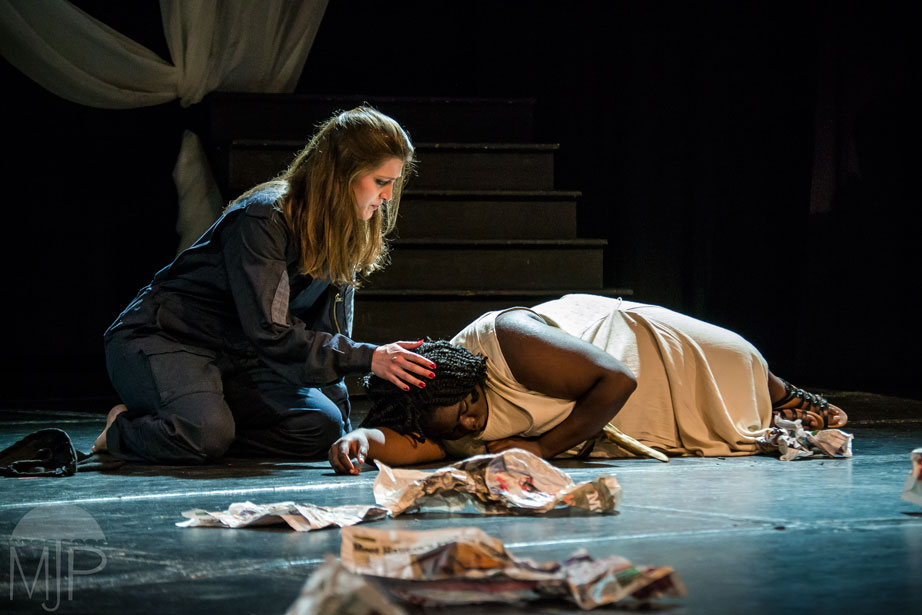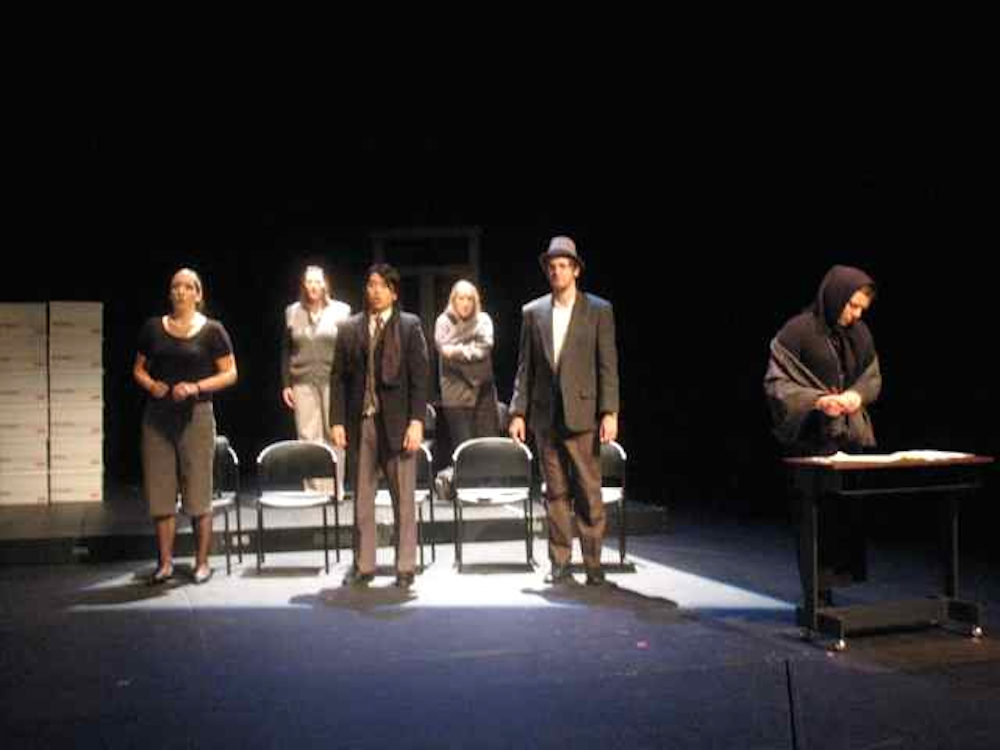Everything you ever wanted to know about Fächer*
by Nina Scott-Stoddart (compiler)
Note: This is based on the text of a handout I’ve used for many years in auditioning masterclasses to help clarify the categories of the Fach system. In defining categories and assigning the roles listed there is inevitably a strong element of subjectivity. I’ve tried to combine both the traditional German system with the looser terms used in North America as I’ve compiled these lists from various sources over the years. It’s far from complete but it may be of use to some.
The German Fach (pl. Fächer) system is a method of classifying singers, primarily opera singers, by the range, weight, and colour of their voices. It’s used primarily in the German-speaking opera houses of Europe. If a singer signed a contract with a company to sing a certain Fach in the company, that singer would be responsible for singing all roles for the company that were designated for that Fach. For that reason, Fach is more specific than voice part and can be a better way of classifying voices.
Although the Fach system is still used in Europe, particularly in Germany, Fächer are still pretty useful for North American singers as a way to help classify one’s own voice in order to decide what to sing and how to market oneself.
Sopranos
Soubrette
Light voice, younger singers, best in middle voice, no extensive coloratura, range from middle C (C4) to high C (C6)
- Susanna, Marriage of Figaro (Mozart)
- Despina, Cosi fan tutte (Mozart)
- Zerlina, Don Giovanni (Mozart)
- Adele, Die Fledermaus (Strauss)
- Nanetta, Falstaff (Verdi) (also sung by Lyric Soprano)
- Lauretta, Gianni Schicchi (Puccini) (also sung by Lyric)
- Musetta, La boheme (Puccini) (also sung by Lyric Soprano)
- Sesto, Giulio Cesare in Egitto (Handel)
Lyric Coloratura
Like a soubrette with an upper extension to E6 or F6, Usually a light soprano, with a high voice. Can often have small voices, meaning they can lack the richness and resonance of voice that for example dramatic sopranos have
- Norina, Don Pasquale (Donizetti)
- Zerbinetta, Ariadne auf Naxos (Strauss)
- Lucia, Lucia di Lammermoor (Donizetti)
- Gilda, Rigoletto (Verdi)
- Lakme, Lakme (Delibes)
- Rosina, Barber of Seville (Rossini) when sung by soprano
- Olympia, Tales of Hoffman (Offenbach)
- Blondchen, Die Entführung aus dem Serail (Mozart)
Lyric Soprano
Beautiful, strong lyrical voice but not heavy, range from middle C to high C. Characters are often noble, self-sacrificing, suffering.
- Micaëla, Carmen (Bizet)
- Marie, Daughter of the Regiment (Donizetti)
- Mimi, La boheme (Puccini)
- Blanche de la Force, Les dialogues des carmelites (Poulenc)
- Countess, Marriage of Figaro (Mozart)
- Antonia, Tales of Hoffman (Offenbach)
- Lauretta, Gianni Schicchi (Puccini) (also sung by Soubrette)
- Liu, Turandot (Puccini)
- Vitellia, La clemenza di Tito (Mozart)
- Sophie, Der Rosenkavalier (Strauss)
- Manon, Manon
- Agathe, Der Freischutz (Weber)
- Jenufa, Jenufa (Janácek)
- Pamina, Die Zauberflote (Mozart)
- Nanetta, Falstaff (Verdi) (also sung by Soubrette)
- Musetta, La boheme (Puccini) (also sung by Soubrette)
- Hanna, Merry Widow (Lehar)
Dramatic Coloratura
voice in quality similar to a lyric soprano, but with an upper extension to F6 and ability for sustained coloratura. Must be able to do fast vocal acrobatics and reach high notes, such as the f6 of the Queen of the Night.
- The Queen of the Night, Die Zauberflöte (Mozart)
- Semiramide, Semiramide (Rossini)
- Elena, La donna del lago (Rossini)
- Violetta, La traviata (Verdi)
- Konstanze, Die Entführung aus dem Serail (Mozart)
- Norma, Norma (Bellini)
- Anne Trulove, Rake’s Progress (Stravinsky)
- Fiordiligi, Cosi fan tutte (Mozart) (also sung by Spinto)
- Cleopatra, Giulio Cesare (Handel
- Lucia, Lucia di Lammermoor, Donizetti
- Margeurite, Faust (Gounod)
Spinto (aka Light Dramatic Soprano)
Stronger voice with more weight and power than lyric soprano, able to sing up to B6 or C6. A light dramatic soprano must generally push her basically lyric instrument to create big sounds that can cut through an orchestral and/or choral climax. Depending on the singer, however, this voice type can be more versatile, as it lies at neither extreme of the soprano spectrum. Spintos are occasionally able to take on lighter mezzo roles, or conversely, lyric and even coloratura roles. Spinto sopranos are known to be especially well suited to art song and operas in English.
- Madama Butterfly, Madama Butterfly (Puccini)
- Manon Lescaut, Manon Lescaut (Puccini)
- Floria Tosca, Tosca (Puccini)
- Alice Ford, Falstaff (Verdi)
- Wally, La Wally, (Catalani)
- Elizabeth de Valois, Don Carlo (Verdi)
- Susannah, Susannah (Floyd)
- Magda, The Consul (Menotti)
- Donna Elvira, Don Giovanni (Mozart)
- Fiordiligi, Cosi fan tutte (Mozart) (also Dramatic Coloratura)
- Santuzza, Cavallaria Rusticana (Mascagni) (also dramatic mezzo)
- Marschellin, Der Rosenkavalier (Strauss)
- Agathe, Der Freischutz (Weber)
- Tatiana, Eugene Onegin (Tchaikovsky)
- Leonora, Il Trovatore (Verdi)
- Russalka, Russalka, (Dvorak)
- Desdemona, Otello (Verdi)
Dramatic Soprano
Heavy and powerful voice able to sing over large orchestras but with lower range, From the B below middle C to the C two octaves above middle C. See also Wagnerian Soprano.
- Elsa, Lohengrin (Wagner)
- Lady Macbeth, Macbeth (Verdi)
- Kundry, Parsifal (Wagner)
- Leonore, Fidelio (Beethoven)
- Aida, Aida (Verdi)
- Isolde, Tristan und Isolde (Wagner)
- Ariadne, Ariadne auf Naxos (Strauss)
- Amelia, Un ballo in maschera (Verdi)
- Leonore, La Forza del destino (Verdi)
- Foreign Princess, Rusalka (Dvorák)
Wagnerian Soprano (aka Hochdramatische Sopran)
From the F below middle C to the C two octaves above middle C
- Turandot, Turandot (Puccini)
- Leonore, Fidelio (Beethoven)
- Brunnhilde, Der Ring des Nibelungen (Wagner)
- Isolde, Tristan und Isolde (Wagner)
- Elektra, Elektra (Strauss)
- Salome, Salome (Strauss)
- Senta, Der fliegende Hollander (Wagner)
Mezzo sopranos / Contraltos
Lyric Mezzo soprano
Lighter mezzo voice, from G below middle C up to a secure B6. A heavier lyric mezzo can also sing Carmen, Charlotte, Dido. Often quite a steely sound. Tessitura sits fairly high in most cases. There are a lot of pants roles in this category!
- Cherubino, Marriage of Figaro (Mozart)
- Dorabella, Cosi fan tutte (Mozart)
- Niklaus, Tales of Hoffman (Offenbach)
- Orfeo, Orfeo (Monteverdi)
- Composer, Ariadne auf Naxos (Strauss)
- Octavian, Der Rosenkavalier (Strauss
- Mignon, Mignon (Thomas)
- Siebel, Faust (Gounod)
- The Secretary, The Consul, (Menotti)
- Sextus, La Clemenza di Tito (Mozart)
- Orlovsky, Die Fledermaus (Strauss)
- Romeo, I Capuleti e I Montecchi (Bellini)
- Mother Marie, Les dialogues des carmelites (Poulenc)
- Sesto, Giulio Cesare in Egitto (Handel)
Lyric mezzos who are Zwischenfach can also often sing some roles listed as “soprano”, eg. Despina from Cosi and Santuzza from Cavallaria.
Coloratura Mezzo soprano
Flexible in the mezzo range. Often just included under label of Lyric mezzo.
- Rosina, Barber of Seville (Rossini)
- Angelina, La Cenerentola (Rossini)
- Julius Caesar, Giulio Cesare in Egitto (Handel)
- Isabella, L’Italiana in Algeri (Rossini) this is actually a coloratura contralto role!
Dramatic Mezzo
Often a similar range to that of the lyric mezzo but with a fuller sound and a lower tessitura. Dramatic mezzos must sometimes perform alongside dramatic sopranos, and so their voices must be able to carry effectively despite singing in a lower tessitura.
- Carmen, Carmen (Bizet)
- Amneris, Aida (Verdi)
- Dido, Dido and Aeneas (Purcell)
- Eboli, Don Carlo (Verdi)
- Fricka, Das Rheingold, Die Walküre (Wagner)
- Ortrud, Lohengrin (Wagner)
- Venus, Tannhauser (Wagner)
- Leonora, La Favorita (Donizetti)
- Adalgisa, Norma (Bellini)
- La Principessa di Bouillon, Adriana Lecouvreur (Cilèa)
- Azucena, Il trovatore (Verdi)
- Madame de Croissy, Les dialogues des carmelites (Poulenc)
- Laura, La Giaconda (Poncielli)
- Charlotte, Werther, Massenet
- Dalila, Samson et Dalila, (Saint-Saëns)
Contralto
A true contralto with a dark, deep voice is quite rare. In operetta she’s usually the comic alto. Also regularly sung by heavier mezzos with good low notes. Range F below middle C to A6
- Ulrica, Un ballo in maschera (Verdi)
- Katisha, Mikado (Sullivan)
- Ruth, Pirates of Penzance (Sullivan)
- Little Buttercup, HMS Pinafore (Sullivan)
- The Mother, The Consul (Menotti)
- Erda, Der Ring des Nibelungen (Wagner)
- Witch, Hansel and Gretel (Humperdink)
- Olga, Eugene Onegin (Tchaicovsky)
- Madam Flora, The Medium (Menotti)
- Pauline, Pique Dame, Tchaicovsky
- Lucretia, The Rape of Lucretia (Britten)
- Madame de Croissy, Les dialogues des carmelites (Poulenc)
- Klytemnestra, Elektra (Strauss)
- Herodias, Salome (Strauss)
Countertenors
Male alto (or, rarely, soprano) singing in the falsetto register. Often sings roles written for castrati in Baroque operas, which would otherwise be sung by female mezzos and contraltos. Although there’s been a push by countertenors to sing mezzo pants roles (like Cherubino in Figaro or Octavian in Rosenkavalier) this is a controversial casting choice.
- Julius Caesar, Giulio Cesare (Handel)
- Bertarido, Rodelinda (Handel)
- Orlando, Orlando (Handel)
- Orfeo, Orfeo (Monteverdi)
- Xerxes, Xerxes (Handel)
- Nerone, Coronation of Poppea (Monteverdi)
- Oberon, Midsummer Night’s Dream (Britten)
- Akhenaten, Akhenaten (Philip Glass)
Tenors
Comic Tenor
either lyric (aka Spieltenor) or dramatic (aka Charaktertenor)
Range up to C5
- Pedrillo, Die Entführung aus dem Serail (Mozart)
- David, Die Meistersinger (Wagner) (heavier)
- Monostatos, Die Zauberflote (Mozart)
- Frantz, Tales of Hoffman (Offenbach)
- Oreste, Ermione (Rossini)
- Giannetto Vingratino, La gazza ladra (Rossini)
- Beppo, I Pagliacci (Leoncavallo)
- Mime, Der Ring des Nibelungen (Wagner) (heavier)
- Sellem, The Rake’s Progress (Stravinsky)
Tenor Leggiero
light and sweet voice with very high range – sometimes conflated with Lyric Tenor
- Count Almaviva, Barber of Seville (Rossini)
- Belmonte, Die Entführung aus dem Serail (Mozart)
- Ferrando, Cosi fan tutte (Mozart)
Lyric Tenor
– range up to C5 with strong but not heavy lyrical voice,
- Rodolfo, La boheme (Puccini)
- Faust, Faust (Gounod)
- Tamino, Die Zauberflote (Mozart)
- Ferrando, Cosi fan tutte (Mozart)
- Ottavio, Don Giovanni (Mozart)
- Ernesto, Don Pasquale (Donizetti)
- Alfredo, La Traviata (Verdi)
- Nemorino, L’elisir d’amore (Donizetti)
- Tito, La clemenza di Tito (Mozart)
Italienischer Tenor
(this is the German fach name for the heavier tenor roles in the Italian style: these roles are often divided up between Sprinto and heavier Lyric voices in other systems)
- Lensky, Eugene Onegin (Tchaikovsky)
- Hoffman, Tales of Hoffman (Offenbach)
- Turiddu, Cavalleria Rusticana (Mascagni)
- Edgardo, Lucia di Lammermoor (Donizetti)
- The Duke, Rigoletto (Verdi)
- Faust, Faust (Gounod)
- Prince, Rusalka (Dvorák)
- Roberto (Leicester), Maria Stuarda (Donizetti)
Spinto (aka Jugendlicher Heldentenor)
range up to B5 with stronger and more full voice,
- Don José, Carmen (Bizet)
- Lohengrin, Lohengrin (Wagner)
- Parsifal, Parsifal (Wagner)
- Pinkerton, Madama Butterfly (Puccini)
- Walter, Die Meistersinger (Wagner)
- Manrico, Il Trovatore (Verdi)
- Canio, I Pagliacci (Leoncavallo)
- Cavaradossi, Tosca (Puccini)
- Calaf, Turandot (Puccini)
- Turiddù, Cavalleria Rusticana (Mascagni)
- Maurizio, Adriana Lecouvreur, Cilèa
- Andreas Chenier, Andreas Chenier, Giordano
Dramatic Tenor (Heldentenor, tenore di forza/robusto)
Range to B5 with powerful voice able to sing over heavy orchestras.
- Siegfried, Der Ring des Nibelungen (Wagner)
- Tristan, Tristan und Isolde (Wagner)
- Otello, Otello (Verdi)
- Florestan, Fidelio (Beethoven)
- Sigmund, Die Walküre (Wagner)
- Radames, Aida (Verdi)
- Samson, Samson et Dalila (Saint-Saens)
- Tannhäuser, Tannhäuser (Wagner)
- Max, Der Freischutz (Weber)
- Parsifal, Parsifal (Wagner)
Baritones / Basses
Lyric Baritone (aka Kavalierbariton)
range to G4-A5, high tessitura and lighter voice
- Conte Almaviva, Le nozze di Figaro (Mozart)
- Marcello, La bohème (Puccini)
- Escamillo, Carmen (Bizet)
- Papageno, Die Zauberflote (Mozart)
- Silvio, I Pagliacci (Leoncavallo)
- Guglielmo, Cosi fan tutte (Mozart)
- Valentin, Faust (Gounod)
- Don Giovanni, Don Giovanni (Mozart)
- Onegin, Eugene Onegin (Tchaikovsky)
- Germont, La Traviata (Verdi)
- Ned Keene, Peter Grimes (Britten)
- Hamlet, Hamlet (Thomas)
- Richard Nixon, Nixon in China (Adams)
- Der Graf, Capriccio (Strauss)
- Oreste, Iphegénie en Tauride (Gluck)
- Achilla, Giulio Cesare in Egitto (Handel)
- Jupiter, Orphée aux Enfers (Offenbach)
Charakterbariton (aka Verdi bariton)
lower tessitura with range to G5, stronger and fuller voice,
- Rigoletto, Rigoletto (Verdi)
- Nick Shadow, The Rake’s Progress (Stravinsky)
- Billy Budd, Billy Budd (Britten)
- Don Carlo, Ernani (Verdi)
- Jack Rance, La fanciulla del West (Puccini)
- Amonasro, Aida (Verdi)
- Scarpia, Tosca (Puccini)
- Escamillo, Carmen (Bizet)
- Di Luna, Il Trovatore (Verdi)
- Dapertutto, Tales of Hoffman (Offenbach)
- Gianni Schicchi, Gianni Schicchi (Puccini)
- Conte di Luna, Il Trovatore (Verdi)
- Nabucco, Nabucco (Verdi)
Dramatic Baritone (aka Heldenbariton)
- Macbeth, Macbeth (Verdi)
- Tonio, Pagliacci (Leoncavallo)
- Iago, Otello (Verdi)
- Alfio, Cavalleria rusticana (Mascagni)
- Michele, I tabarro (Puccini)
- Telramund, Lohengrin (Wagner)
Dramatic Bass-Baritone
Range from about E3 to F5
- Wotan, The Ring Cycle (Wagner)
- The Dutchman, Der fliegende Holländer (Wagner)
- Sachs, Die Meistersinger von Nürnberg (Wagner)
- Banquo, Macbeth (Verdi)
- Klingsor, Parsifal (Wagner)
- Phillip, Don Carlo (Verdi)
Spielbass (aka bass buffo, comic bass) – sometimes divided into lyric and dramatic
- Leporello, Don Giovanni (Mozart)
- Colline, La bohéme (Puccini)
- Falstaff, Falstaff (Verdi)
- Don Alfonso, Cosi fan tutte (Mozart)
- Mephistopheles, Faust (Gounod)
- Don Pasquale, Don Pasquale (Donizetti)
- Figaro, Marriage of Figaro (Mozart)
- Bartolo, Marriage of Figaro (Mozart)
- Bartolo, Barber of Seville (Rossini)
- Basilio, Barber of Seville (Rossini)
- Sacristan, Tosca (Puccini)
- Chou En-Lai, Nixon in China (Adams)
- Dulcamara, L’elisir d’amore (Donizetti)
- Uberto, La serva padrona (Pergolesi)
- Sulpice, La fille du régiment (Donizetti)
Heavy Bass (aka Seriöser Bass) – sometimes divided into Lyric and Dramatic
range C 2 octaves below middle C to E5, lowest voice, dark and deep
- Sarastro, Die Zauberflote (Mozart)
- Rocco, Fidelio (Beethoven)
- King Henry, Lohengrin (Wagner)
- König Marke, Tristan und Isolde (Wagner)
- Der baron Ochs, Der Rosenkavalier (Strauss)
- Hermann, Tannhäuser (Wagner)
- Osmin, Die Entführung aus dem Serail (Mozart)
- Prince Gremin, Eugen Onegin (Tchaikovsky)
- Claudius, Hamlet (Thomas)
- Trulove, The Rake’s Progress (Stravinsky)
- Il Commendatore, Don Giovanni (Mozart)
- Sparafucile, Tosca (Puccini)
- John Claggart, Billy Budd (Britten)
- Vodnik the Water Goblin, Rusalka (Dvorák)
- Hunding, Die Walküre (Wagner)
* but were afraid to ask.





